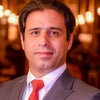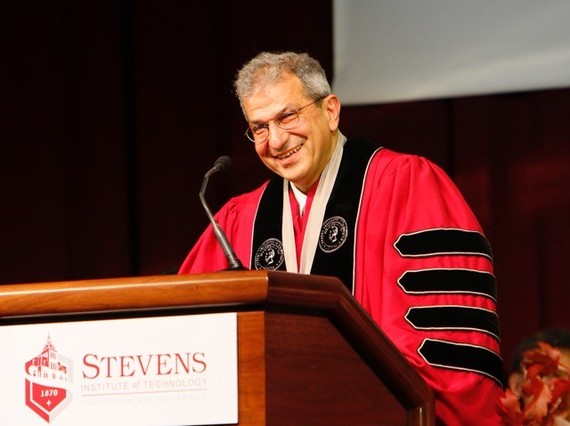To read the first part of interview chick here.
What would you like to focus on during your time as a president? What is the strategic focus of the school now and how has that evolved over time?
The history of Stevens Institute of Technology has always been one of technological innovation and entrepreneurship. The Stevens family, though not as well-known as they deserve to be, can literally be regarded as America's first family of inventors. They are responsible for transportation innovations in steam ships and railroads, and they played a significant role in the establishment of U.S. patent law.
The Stevens of today and of the future honors this legacy by instilling in our students the ability to conceive of technologies that solve problems, that improve lives, and that advance progress across diverse domains. For example, we are focusing on healthcare innovation, developing new approaches to treat cancer, new biomedical devices that improve the human condition, new techniques to accelerate drug discovery, and new methodologies for targeted drug delivery. Similarly, we are working on a host of issues related to environmental sustainability and alternative energy, ranging from developing a net zero energy solar house to new technologies that utilize photovoltaic ink with an inkjet printer to print low-cost solar electronics. We also have one of the strongest centers in the country to study the physical dynamics of coastal ocean circulation and, in particular, to forecast the magnitude of water surge and flooding during extreme weather events, such as a hurricane. These are just a few examples of research focused on major societal concerns.
We deliberately and diligently focus on innovation and entrepreneurship throughout our educational and research programs. Technology is, in my opinion, the principal driver of societal, industrial, and even personal progress. New technologies have been--and will continue to be--introduced that have literally changed the way we live and work, that save and extend lives, that make the previously impossible possible. As such, Stevens makes a concerted effort to offer a technology-centered education to all of its students regardless of their disciplinary focus, from computer science, to music, business and finance. Of course, we need a humanistic appreciation of the role and impact of technology on individuals, institutions and society as well. So Stevens also has a deep tradition in the arts and humanities, and we continue to refine and improve upon what it means to be a literate and ethical person in a society that is heavily influenced by technology.
What do you think are some of the leadership qualities a President of Institute of Technology should have?
It is fortuitous that you ask this question. I gave a lecture on leadership to the students in my freshman class last week, focusing on the seven most important attributes of a leader. So, the answer is fresh in my mind. In my opinion, effective leaders
1.have the ability to both create a vision and convert the vision into action;
2.are intense and relentless, determined to succeed, work extremely hard and exude energy;
3.earn the trust of the people they work with and for through their integrity, humility, honesty and sincerity;
4.communicate well, listen well, motivate, inspire, energize and mobilize their team toward an ambitious destination;
5.demonstrate courage in making difficult decisions and taking calculated risk;
6.surround themselves with the best people; and are selfless.
Needless to say, to be an effective president at an institute of technology, in addition to the above qualities, one needs to have a significant amount of experience in technology education and a deep appreciation for the critical role technology plays in literally every aspect of modern life.
What was your transition like from UMD (a large public institution) to Stevens, which is a smaller and private institution? How is the role of a provost in a university different from a president?
The transition was pleasantly smooth. The Stevens community was incredibly welcoming, making my and my family's transition extremely enjoyable. At the University of Maryland I had held different positions at the department and school levels prior to becoming provost and, therefore, I was comfortable working in a smaller setting. So, the transition from the position of provost in a large university to president in a smaller university was easy to deal with. Both positions of Provost at the University of Maryland and President at Stevens come with significant responsibilities, complexities, and accountabilities, though the Provost at Maryland is more focused on internal academic matters, whereas the President at Stevens has lower degree of focus on academics and more on external matters. Having said this, there is one important point that I must make. At a university like Stevens it is a lot easier to get things done and effect change. The size of the university, the disciplinary synergies and less bureaucracy make it possible to make decisions and implement them quickly. This has been the most enjoyable difference between my previous job at Maryland and the current position at Stevens.
Can you share an interesting anecdote about something you've experienced throughout your career as inventor, educator, and engineer? What are some of your favorite teaching moments and why?
One of my most favorite and memorable experiences goes back to my very first teaching experience at age nine. That was a life-changing experience, which taught me something about myself and gave me a taste of the satisfaction one may get out of doing good for others. I will never forget the spark of joy and appreciation I saw in the eyes of my classmate's mother when she came to school to thank me for what I had done for her daughter. Another truly important and enjoyable experience I had recently was my involvement with the Stevens entry in the U.S. Department of Energy's Solar Decathlon. The Stevens entry, called the SURE (SUstainable+REsilient) HOUSE, was a net zero energy house fully powered by solar energy and designed to withstand the power of a hurricane. SURE HOUSE took first place in this important competition. This was a nearly two-year effort, and I knew our team could win. During the first part of the competition, I kept in close touch with the team--literally day and night--via texts and emails. I analyzed the results of each of the contests at the end of each day. To say that I was invested in the competition is an understatement. My wife and I had the thrill of being with our team when it was announced that Stevens had won seven of 10 contests and was the overall winner. I literally jumped for joy when I heard the news.
How can prospective engineering students assess their skill and aptitude?
Engineers like to solve problems. They tend to have a curious mind and imagine ways they can improve upon things. Over the years, there have been many stereotypes about engineers as being socially awkward, but I think society is now seeing engineers differently. Engineers are the innovators and inventors who imagine and create products, technologies, and systems that make the world a better place across diverse fields such as biomedicine, telecommunications, and alternative energy. There are many engineers at the helm of major Fortune 100 corporations and many more who launched innovative technology start-ups that have become corporate giants, creating tens of thousands of jobs and changing our lives. Engineers need to have a good foundation in and an aptitude for mathematics and physical sciences, and an interest in solving problems and making things, but they also need creativity and strong interpersonal skills. If students see some of these characteristics in themselves, they would do well to consider an engineering career.
What portion of your graduate students are immigrants? Which countries send you the most students? How can we make it easier for them to stay in the U.S.?
At the undergraduate level, less than five percent of our students are international students. However, at the graduate level, nearly 50 percent of our students come from other countries, the majority of which are from China and India, although there is representation from other Asian countries, the Middle East, Europe and Latin America, as well. It is important to mention that unlike many years ago when the great majority of international students wanted to be able to stay in the U.S. after completing their studies, today many international students tend to go back to their home country or to other countries that provide them the best career opportunities. This is especially true about students from China, who tend to return to China where they can find an abundance of career opportunities. Also, our immigration policies are less friendly than they used to be, making it less inviting for international students to pursue their careers in the U. S. I believe there is room for improving our immigration policies to make them more attractive to those professionals whose skills and experiences are difficult to find in the U.S.

